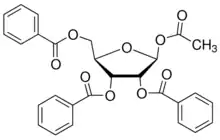1-O-Acetyl-2,3,5-tri-O-benzoyl-beta-D-ribofuranose
1-O-Acetyl-2,3,5-tri-O-benzoyl-beta-D-ribofuranose, also called β-D-ribofuranose 1-acetate 2,3,5-tribenzoate, is a ribose-derived compound used in nucleoside synthesis.[1]
 | |
| Names | |
|---|---|
| IUPAC name
β-D-Ribofuranose 1-acetate 2,3,5-tribenzoate | |
| Systematic IUPAC name
(2S,3R,4R,5R)-2-(Acetyloxy)-5-[(benzoyloxy)methyl]oxolane-3,4-diyl dibenzoate | |
| Identifiers | |
3D model (JSmol) |
|
| ChemSpider | |
| ECHA InfoCard | 100.027.474 |
| EC Number |
|
PubChem CID |
|
CompTox Dashboard (EPA) |
|
| |
| |
| Properties | |
| C28H24O9 | |
| Molar mass | 504.491 g·mol−1 |
Except where otherwise noted, data are given for materials in their standard state (at 25 °C [77 °F], 100 kPa).
Infobox references | |
Industrial synthesis
In the patented formation of 1-O-acetyl-2,3,5-tri-O-benzoyl-beta-L-ribofuranose, a reactor containing thionyl chloride (5 ml) and methyl alcohol (100 ml) is stirred at 0–5 °C for 10 to 15 minutes. After this period, 10 g (ratio-wise) of ribose is added to the flask. The flask is then stirred and maintained at its temperature for 8 hours. During this period, a methylation reaction will occur on the ribose. After the 8-hour period of methylation, the flask will be filled with 150 ml of ethyl acetate, 5 ml pyridine, and 30 g potassium carbonate. The flask will then be heated to 60–70 °C. Over 99 minutes at this temperature, 30 ml of the chemical benzyl chloride will be intermittently dripped into the flask to react with the ribose directly. After this period, the flask will be left for 4 to 8 hours to continue reacting. The subsequent solid nonacetylated ribose benzyl glycoside will be isolated by neutralizing the flask liquid by addition of sulfuric acid, then suction of the precipitate (the non-acetylated ribose benzyl glycoside). The benzyl ribose glucoside will then be put into a separate flask. In this flask, glacial acetic acid and acetic anhydride will be mixed with the benzyl glycoside under a maintained temperature from −5 to 5 °C for 5 hours. The 1-O-acetyl-2,3,5-tri-O-benzoyl-beta-L-ribofuranose will be the product yielded after recrystallization with ethyl alcohol and isolation by known filtering methods.[2]
Use in artificial nucleotide synthesis
1-O-Acetyl-2,3,5-tri-O-benzoyl-beta-D-ribofuranose is further reacted with Trimethylsilyl trifluoromethanesulfonate (TMSOTf) under the silyl-Hilbert–Johnson reaction and deprotected by an acid or base to form a pure artificial nucleotide.
References
- Niedballa, U.; Vorbrueggen, H. (1976-06-01). "Synthesis of nucleosides 17. A general synthesis of N-glycosides. 6. On the mechanism of the stannic chloride catalyzed silyl Hilbert–Johnson reaction". The Journal of Organic Chemistry. 41 (12): 2084–2086. doi:10.1021/jo00874a002. ISSN 0022-3263. PMID 932850.
- CN 102659856, Ao, Chen; Minghai, Li & Zhengyi, Chen et al., "Preparation technology of 1-O-acetyl-2,3,5-tri-O-benzoyl-beta-D-ribofuranose", published 2012-09-12, issued 2012-04-10, assigned to Changzhou Kangli Pharmaceutical Co. Ltd.